|
|
|
| Environmental
Responsibilities
Aiming for a better quality of life for the community represents
an underlying principle of the day-to-day operation of EMSD.
We are aware that our operations can impact the environment
in the course of rendering services to customers and the public.
To conserve the environment, our first priority is to avoid
creating environmental pollution, or reduce the impact if
pollution is inevitable. We reduce impact where it is created,
enhance the environment where we operate and conserve resources
over the long term. Our efforts include reducing the energy,
water and other resources and materials consumed in the course
of rendering our services, while minimising pollutants such
as emissions, effluents and wastes.
To support the Government’s commitment
to the Clean Air Charter and improve air quality, we have
also implemented various measures, details of which are found
on here. |
|
|
| Environmental
Management System
Our performance in environmental aspect is mainly governed
by the Environmental Management System (EMS) which has evolved
over the years. First implemented in the mid-1990s, EMS featured
a decentralised management framework with each division ensuring
that its operations comply with internationally recognised
standards and the legislative requirements in Hong Kong. In
2000, we took a step forward and became the first government
agency to attain the ISO14001 Corporate Certificate. In 2002,
we streamlined our various management systems in quality,
environment and occupational health and safety, and combined
them into an Integrated Management System (IMS) which is the
system in current use. |
|
|
Environmental
Policy
|
| Our Goal
The management and staff of the Electrical and
Mechanical Services Department are committed to
building a better environment through an ongoing
environment conservation, protection and improvement
programme.
Our Policy
- To take pride in ourselves as a responsible
organisation that is helping to build a better
environment.
- To take every reasonable and practicable
measure to conserve resources, minimise the
generation of waste and prevent pollution in
each and every one of our business operation
processes.
- To comply with green legislation as the baseline
of our operations and to ensure that all staff
behave accordingly.
- To encourage our contractors and their staff
to be equally friendly to the environment.
- To ensure that our environment management
system conforms to internationally recognised
ISO 14001 standards.
|
|
|
|
|
|
A
Leading Role in Energy Conservation Initiatives
We welcome the APEC Leaders‘ Declaration on Climate Change,
Energy Security and Clean Development adopted in Sydney in
2007. As an APEC member, Hong Kong will honour its pledge
to support the Declaration and seek to achieve a reduction
in energy intensity of at least 25% by 2030 (with 2005 as
the base year).
In fact, ever since the 1990s, EMSD has launched many pioneering
energy conservation schemes. Our energy conservation work
has two aspects: promoting energy efficiency and encouraging
the wider use of renewable energy. Highlighted below are the
latest developments in our efforts to support Government’s
policy to step up energy conservation. |
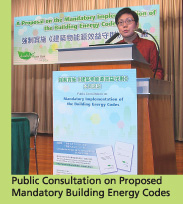 |
Proposed Mandatory
Energy Efficiency Labelling Scheme
The Government has proposed a mandatory Energy Efficiency
Labelling Scheme covering room air conditioners, refrigerating
appliances and compact fluorescent lamps in the initial phase.
The Energy Efficiency (Labelling of Products) Bill was introduced
to the Legislative Council in 2007 and was passed in April
2008. It was estimated that the Scheme could help reducing
150 GWh of electricity consumption annually.
Proposed Mandatory Building Energy
Codes
To promote energy efficiency in buildings, the Government
conducted a 3-month consultation on the mandatory implementation
of the Building Energy Codes from December 2007 to March 2008.
Various stakeholders and the community were consulted on the
proposal through a variety of channels such as the media,
professional conferences, technical talks and public forums.
The views and comments collected will be considered in drafting
of the legislative proposal, which is planned to be introduced
to the Legislative Council in 2009.
|
|
Scheme to Promote
Fresh Water Cooling Towers
The Scheme aims to promote the wider use of fresh water evaporative
cooling towers in air-conditioning systems which are more
energy efficient than air-cooled systems. As of 31 March 2008,
a total of 82 areas has been designated for the Scheme, including
the newly designated areas of Mid-levels West and Pak Shek
Kok.
Since the commencement of the Pilot Scheme and up till 31
March 2008, we have received over 340 applications, and 116
installations with a total cooling capacity of 647,000 kW
have been completed and put into operation. We estimate that
this would save electricity by 93 million kWh per annum and
reduce green house gases by 65,000 tonnes per annum. |
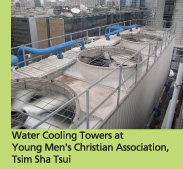 |
The 2nd
Hong Kong Energy Efficiency Awards
The competition aims to encourage the public to save energy,
promote best practices, as well as to commend those who have
made efforts, innovations and achievements in energy efficiency
and conservation. This year’s Awards competition attracted
more than 1,400 entries between January and August 2007, and
the winners achieved outstanding results. In the “Common Areas”
category, energy savings of around 34% was registered when
compared with the same period in the preceding year. For the
“Households” and “Tenants” categories, some winners achieved
energy saving of more than 40% and 20% respectively.
|
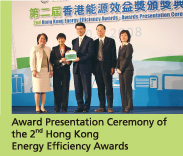 |
Promotion
of Renewable Energy
Grid Connection of Renewable Energy
Power Systems
To keep pace with changes in international standards and technological
advancements in trade and industry, EMSD published the Technical
Guidelines on Grid Connection of Renewable Energy Power Systems
(2007 Edition). Compared with the first edition issued in 2005,
the application range in the new edition has been increased
from 200kW to 1000 kW in respect of the Aggregated Power Rating
of the system. |
 |
|
|
Conservation
of Operational Resources
Electricity
The total purchased electricity was 12.82 GWh in 2007/08,
covering Kowloon Bay headquarters, Caroline Hill workshop,
Fan Garden vehicle depot, Siu Ho Wan vehicle depot, and EMSD
workshop at Chek Lap Kok Air Mail Centre. From 2005/06 to
2007/08, there has been a general decline in electricity consumption.

| * |
Note: EMSD relocated its headquarters from Caroline
Hill Road to Kowloon Bay in 2005/06. As a result of phased
relocation, there was parallel operation of both the old
and new headquarters buildings for a brief period leading
to a higher consumption level in that year. The increase
in consumption was also attributed to the provision of
many new facilities in the new headquarters building such
as the Corporate Data Centre, Education Path on Energy
Efficiency and Safety and training centre for electrical
workers. The structural features of the new headquarters
building such as the high ceiling and wide circulation
area also led to more electricity consumption. The total
electricity consumption would have been lower if the additional
electricity consumption arising from new facilities and
structural features is discounted for a like-to-like comparison. |
EMSD strives to continuously look for opportunities for energy
saving. The electricity consumption in 2007/08 was lower than
that in 2006/07. The factors leading to the decrease included
installing occupancy sensors in toilets, fine-tuning the occupancy
sensors in office areas and common areas to reduce the idle
time, carrying out de-lamping in over illuminated area (a
total of 832 lighting fixtures were removed in the period
between August 2007 and September 2007), and tightening up
of house-keeping measures.
Besides, a departmental wide energy conservation campaign
was launched in June 2007 to raise the energy efficiency awareness
of our management and staff. Several simple and effective
housekeeping measures were promoted throughout this campaign:
| (i) |
Adjust the room temperature setting (where there is
separate air-conditioning control) to 25.5°C in summer
months |
| (ii) |
Switch off all electrical appliances after office hours
and avoid leaving the office equipment, computers and
printers in stand-by mode |
| (iii) |
Appoint energy wardens to remind colleagues to comply
with all housekeeping measures |
| (iv) |
Use 7-day timer switch to automatically switch off equipment
after office hours |
Gas
Towngas used to be the major fuel for hot water supply in
the former Caroline Hill headquarters and the Kowloon workshop.
There was a drop in the towngas consumption in 2006/07 after
relocation of the headquarters to Kowloon Bay as the new headquarters
use a mix of heat pumps, electric boilers and solar water
heating system for water heating. The Caroline Hill workshop
is the remaining major venue using towngas for water heating.
The consumption has continued to decline to around 317,000
MJ in 2007/08 with the stepping up of housekeeping measures.
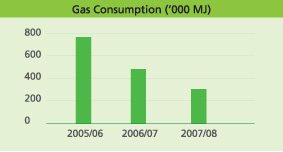
Water
Water is mainly consumed for air-conditioning, gardening,
drinking and cleaning. The overall consumption was around
69,000 m3 in 2007/08 covering major venues including Caroline
Hill workshop and headquarters at Kowloon Bay, representing
a decrease of about 18% compared with that of the previous
year. The reduction was attributable to a number of factors,
including the cessation of short term usage of the former
Caroline Hill headquarters by a few other departments, use
of recycled grey water for gardening at Kowloon Bay headquarters,
and so on.
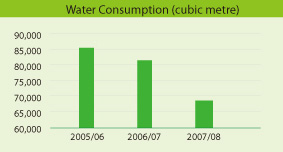
Materials
Materials Used in Offices
Paper
Paper is mainly used for photocopying and printing. We make
every effort to reduce our paper consumption, such as the
use of an electronic Document Management System. In 2007/08,
paper consumption dropped by 4% on the consumption in 2006/07.
Since 2001, we have adopted the extensive use of environment-friendly
recycled paper made from recycled fibre. In 2007/08, 81% of
our total paper consumption was recycled paper. Use of virgin
paper was limited to external documents only and is avoided
as much as practicable.
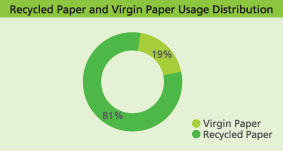
Toner Cartridges
We purchased some 2,800 toner cartridges in 2007/08 and we
have followed government initiatives to recycle all used toner
cartridges since 2005/06.
Materials Used in Workshops
We recognise that the materials, parts and products used in
our everyday operations impact the environment in different
ways through their production, use and ultimate disposal.
EMSD will work to reduce the use of materials, recondition
and re-use them whenever possible in order to sustain resources
over the long term. For details of our performance in industrial
materials consumption, please refer to the section “Summary
of Statistics”. |
 |
|
|
Emissions,
Effluents and Wastes
We are aware that our operations produce waste and impact
the environment. Our waste management strategy is to maximise
material recycling and minimise unavoidable waste generation.
Waste is primarily generated from two sources – offices and
workshops. The following sections detail our progress in the
past 12 months.
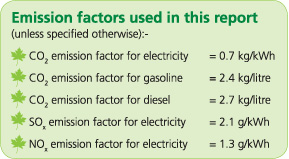
|
Waste Generated
|
| Waste from Offices
Waste Paper
Waste paper is one of our major items for recycling.
Paper is used everyday in our offices, and therefore
an effective and efficient channel for collecting
and handling waste paper is needed for proper
waste management. Waste paper is collected through
various collection points and picked up by paper
recyclers. In 2007/08, we collected some 17,000
kg of waste paper for recycling.
Toner Cartridges
Used toner cartridges are collected by recycling
collectors, refilled and reused. We collected
about 3,000 toner cartridges for recycling in
2007/08. |
|
Waste from Workshops
Waste Oil
Waste oil is generated from our workshops while
rendering service to our customers, in particular
our vehicle maintenance services. Waste oil is
collected regularly by registered chemical waste
collectors and treated in registered chemical
waste treatment facilities. In 2007/08, about
129,000 litres of waste oil were collected for
recycling or disposal in accordance with the relevant
ordinance.
Spent Mercury Lamps
Spent mercury lamps are collected from offices
and workshops by registered chemical waste collectors
and delivered to the Chemical Waste Treatment
Centre in Tsing Yi for recycling. In 2007/08,
over 107,000 spent mercury lamps were collected
and recycled.
Used Rechargeable Batteries
Used rechargeable batteries contain rare metals
that can be recovered and reused. We have adopted
and implemented a programme launched by the Environmental
Protection Department (EPD) to recycle domestic
type rechargeable batteries, and, in addition,
collect industrial type batteries generated from
our operations for recycling. More information
can be found in the Summary of Statistics.
Metal Scraps
Metal scraps are valuable natural resources which
can be completely recycled and reused without
deterioration in their composition during the
recycling processes. Most metal scraps generated
from our operations such as vehicle maintenance
have been collected and recycled. In 2007/08,
about 48,000 kg of metal scraps were collected.
Used Vehicle Tyres
Used vehicle tyres arise from our vehicle maintenance
services for government vehicles. They are collected
and recycled by local waste tyre collectors listed
on the EPD’s directory. More than 12,000 tyres
were collected and another 541 tyres were retreaded
for further use on vehicles in 2007/08. |
|
|
Emissions
Greenhouse Gas Emissions
Greenhouse gas (GHG) emissions are widely acknowledged as
a cause of global warming and climate change, and reducing
emissions such as CO2 is one of our biggest challenges.
EMSD’s greenhouse gas emissions are mainly attributed to the
consumption of electricity in our offices and workshops, and
transport. In 2007/08, direct emissions from our transport
activities amounted to some 1,300 tonnes of CO2
whereas our electricity consumption gave rise to about 9,000
tonnes of CO2.
Transport
The use of transport in EMSD operations consumes non-renewable
fossil fuels and generates GHG emissions. We have a fleet
of around 250 vehicles including lorries, vans, saloon cars
and motorcycles to carry out our services, and at the same
time maintain over 5,800 government vehicles for our client
departments. We have to ensure that the emissions from such
activities are reduced to a minimum by good housekeeping,
proper vehicle maintenance, reduced use of transport or switching
to hybrid vehicles. We now have two hybrid vehicles, which
consume 40% less fuel than conventional cars of similar size. |
|
|
|
| |
|
|
|
|


